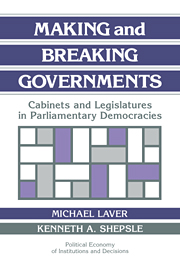4 - Government equilibrium
Published online by Cambridge University Press: 06 January 2010
Summary
In the previous chapter we set out a stylized description of the government formation process in parliamentary democracies. This description is, in effect, a logical model of government formation. In this chapter, we begin to unfold some of the implications of our model, exploring ways in which it might increase our understanding of what it takes to make and break a government.
Since we are interested in what it takes for a government to form and stay formed, an important thread running through the rest of the argument of this book is the concept of an equilibrium cabinet – a notion that we hope is more or less intuitive. An equilibrium cabinet, once it is formed, stays formed because no political actor with the ability to act in such a way as to bring down the cabinet and replace it with some alternative has the incentive to do so. Conversely, no actor with the incentive to replace the cabinet with some alternative has the ability to do so. Thus we expect an equilibrium cabinet to be stable, remaining in place until a change in the external environment transforms either the incentives of some pivotal actor or the “pivotalness” of some actor already possessing the appropriate incentives. (For example, an opposition party may, as a result of by-elections or defections from other parties, increase its weight and thereby the extent to which it is pivotal.) We do not expect a cabinet that is out of equilibrium to be stable, since at least one actor who has an incentive to bring down the government also has the ability to do so.
Political equilibriums can be attractive, retentive, or both.
- Type
- Chapter
- Information
- Making and Breaking GovernmentsCabinets and Legislatures in Parliamentary Democracies, pp. 61 - 89Publisher: Cambridge University PressPrint publication year: 1996

